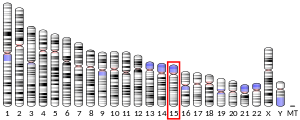^ a b c ENSG00000288478 GRCh38: Ensembl release 89: ENSG00000170113, ENSG00000288478 – Ensembl , May 2017^ a b c GRCm38: Ensembl release 89: ENSMUSG00000047037 – Ensembl , May 2017^ "Human PubMed Reference:" . National Center for Biotechnology Information, U.S. National Library of Medicine .^ "Mouse PubMed Reference:" . National Center for Biotechnology Information, U.S. National Library of Medicine .^ Rainier S, Chai JH, Tokarz D, Nicholls RD, Fink JK (Sep 2003). "NIPA1 gene mutations cause autosomal dominant hereditary spastic paraplegia (SPG6)" . Am J Hum Genet . 73 (4): 967–71. doi :10.1086/378817 . PMC 1180617 PMID 14508710 . ^ "Entrez Gene: NIPA1 non imprinted in Prader-Willi/Angelman syndrome 1" .^ Goytain A, Hines RM, El-Husseini A, Quamme GA (2007). "NIPA1(SPG6), the basis for autosomal dominant form of hereditary spastic paraplegia, encodes a functional Mg2+ transporter" . J. Biol. Chem . 282 (11): 8060–8. doi :10.1074/jbc.M610314200 PMID 17166836 . ^ Reed JA, Wilkinson PA, Patel H, et al. (2005). "A novel NIPA1 mutation associated with a pure form of autosomal dominant hereditary spastic paraplegia". Neurogenetics . 6 (2): 79–84. doi :10.1007/s10048-004-0209-9 . PMID 15711826 . S2CID 2236413 . ^ Rainier S, Chai JH, Tokarz D, et al. (2003). "NIPA1 gene mutations cause autosomal dominant hereditary spastic paraplegia (SPG6)" . Am. J. Hum. Genet . 73 (4): 967–71. doi :10.1086/378817 . PMC 1180617 PMID 14508710 .
Bittel DC, Kibiryeva N, Butler MG (2006). "Expression of 4 genes between chromosome 15 breakpoints 1 and 2 and behavioral outcomes in Prader-Willi syndrome" . Pediatrics . 118 (4): e1276–83. doi :10.1542/peds.2006-0424 . PMC 5453799 PMID 16982806 . Liu T, Qian WJ, Gritsenko MA, et al. (2006). "Human plasma N-glycoproteome analysis by immunoaffinity subtraction, hydrazide chemistry, and mass spectrometry" . J. Proteome Res . 4 (6): 2070–80. doi :10.1021/pr0502065 . PMC 1850943 PMID 16335952 . Munhoz RP, Kawarai T, Teive HA, et al. (2006). "Clinical and genetic study of a Brazilian family with spastic paraplegia (SPG6 locus)" . Mov. Disord . 21 (2): 279–81. doi :10.1002/mds.20775 PMID 16267846 . S2CID 21070143 . Chen S, Song C, Guo H, et al. (2006). "Distinct novel mutations affecting the same base in the NIPA1 gene cause autosomal dominant hereditary spastic paraplegia in two Chinese families" . Hum. Mutat . 25 (2): 135–41. doi :10.1002/humu.20126 PMID 15643603 . S2CID 5773016 . Chai JH, Locke DP, Greally JM, et al. (2003). "Identification of four highly conserved genes between breakpoint hotspots BP1 and BP2 of the Prader-Willi/Angelman syndromes deletion region that have undergone evolutionary transposition mediated by flanking duplicons" . Am. J. Hum. Genet . 73 (4): 898–925. doi :10.1086/378816 . PMC 1180611 PMID 14508708 . Toyoda N, Nagai S, Terashima Y, et al. (2003). "Analysis of mRNA with microsomal fractionation using a SAGE-based DNA microarray system facilitates identification of the genes encoding secretory proteins" . Genome Res . 13 (7): 1728–36. doi :10.1101/gr.709603 . PMC 403746 PMID 12805275 . Strausberg RL, Feingold EA, Grouse LH, et al. (2003). "Generation and initial analysis of more than 15,000 full-length human and mouse cDNA sequences" . Proc. Natl. Acad. Sci. U.S.A . 99 (26): 16899–903. Bibcode :2002PNAS...9916899M . doi :10.1073/pnas.242603899 PMC 139241 PMID 12477932 . Fink JK, Jones SM, Sharp GB, et al. (1996). "Hereditary spastic paraplegia linked to chromosome 15q: Analysis of candidate genes". Neurology . 46 (3): 835–6. doi :10.1212/wnl.46.3.835 . PMID 8618696 . S2CID 39414032 . Fink JK, Wu CT, Jones SM, et al. (1995). "Autosomal dominant familial spastic paraplegia: tight linkage to chromosome 15q" . Am. J. Hum. Genet . 56 (1): 188–92. PMC 1801321 PMID 7825577 .



